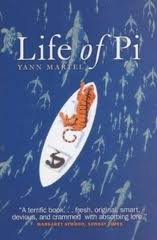 A Well-told Story With A Hidden Agenda
A Well-told Story With A Hidden Agenda
Martel, Yann (2001). Life of Pi. New York: Random/Harcourt.
This adventure novel recalls Defoe’s Robinson Crusoe, and the middle part is a rousing adventure tale of a boy castaway at sea that would be enjoyed by young readers. The boy, perhaps 15, lives in southeastern India and takes on the nickname, “Pi.” The suggestive title of the book has nothing to do with mathematics.
A prologue, cleverly called “Author’s Note,” is critical to the structure of the book. In a few italicized pages, the author describes, in realistic journalistic prose, how he discovered Pi as an adult in 1996 and interviewed him, learning his story. That is the framing device for the narrative that follows in Pi’s own voice, presented as a recorded oral history.
Pi begins as a son of a Indian zookeeper.He studies Hinduism, Christianity, and Islam, to the distress of his family, and spouts vapid, sentimental philosophy and authoritarian opinions that sometimes verge on cheesy poetry. (“We are all born Catholics.” “Agnostics choose doubt, which is like choosing immobility as a form of transport.”) This naïve philosophizing is important spadework for Martel’s later thesis: Only humans, not animals, are concerned about religion.
Pi’s discourses on animals also serve an important purpose, to define and condemn anthropomorphism, the spurious attribution of human characteristics to animals, an error to which nearly all uneducated people are prone. This point is crucial for understanding the rest of Pi’s story and Martel’s ultimate agenda, and is very skillfully inserted into the text.
In a half dozen, interspersed, short chapters of a few paragraphs each, the presumptive author (not Martel, but the fictional journalist who wrote the prologue to Pi’s story) describes, in italic font, the old man, Pi, who he interviewed. This clever device gives further anthropological credence to the memoir, building the case that it is a true story, but it also muddies Pi’s voice.
Pi, the child, is given to pompous speechifying, and is not much of a natural storyteller. Martel tries to leaven the dense exposition by having Pi address the reader directly with phrases such as “…if I may say so myself,” or, “So you see…” This technique attempts to remind the reader that this is an orally presented story by a young boy. However, sometimes Pi uses cutesy, childish phrases, and in the next sentence Latinate constructions and sophisticated adult concepts and vocabulary. This ambiguous mix of childish and adult diction prevented me from engaging with the character.
With all the pins set up, we are ready to bowl. The zoo must be closed. The animals are caged and loaded onto a cargo ship like Noah’s ark, and several days out in the western Pacific, the ship sinks. Life boats are launched and Pi shares one with an enormous Bengal tiger, an orangutan, a hyena, and a zebra.
Much of the subsequent drama depends on the universal childish fear of being eaten by wild animals. If Pi had been castaway with only the zebra, the story just wouldn’t have worked. In due course, the tiger eats all the other animals with bloody tooth and claw, leaving only Pi and the tiger. Pi builds a raft out of oars and life jackets, tethering it to the boat, so he doesn’t have to sleep near the tiger. He catches fish and turtles, and deploys solar stills found in the lifeboat.
The two castaways are literally dying of dehydration and hunger, yet the detailed descriptions of daily behavior include gallons of fresh water from the stills and abundant sea life. Much of the adventure depends on enduring deprivation, yet having renewable food and water lets the story drag on, with the castaways surviving seven months at sea. That story device stuck out as an unconvincing error.
Another problem was Pi’s decision to keep the tiger alive by feeding him some of his food and water, a decision not well-explained. Pi, did not believe in anthropomorphism, was not sentimental about the tiger, and was terrified by it. So why didn’t he just wait him out? That decision is key to the story, of course, since there would be no story without the tiger, but it was another artificial device that didn’t make any sense.
As hunger and thirst become dire, Pi becomes “animalistic.” He catches fish with his bare hands and bites their heads off and sucks out their eyeballs, and so on. This supposed descent into animality is well described and constitutes the best part of the adventure story. However, Martel has an agenda, so Pi periodically must spout religious ideas to show that he is still a human, superior to the tiger, not a mere animal. That device, I found artificial, heavy-handed, and not convincing, but it is a core message of the book.
After the rousing and vivid adventure story of the castaways, which exhausts every conceivable event that could happen (weather, sharks, hallucinations, etc.), the castaways make landfall in Mexico. The tiger escapes into the jungle and Pi recovers with villagers. Officials from the shipping company come to interview him, hoping to learn why their boat sank. He tells the story of his survival. The officials simply don’t believe it, because it “goes against nature,” they say. Pi retorts that many things are hard to believe if you have not personally experienced them, such as God. And, ta-da! Martel unveils his argument that belief in God is based on personal experience which no amount of skepticism can penetrate. While the argument is old and tired, unworthy of argumentation, its dramatization nevertheless makes for a good read by a skillful author, as long as you don’t mind being sucker-punched at the end.
